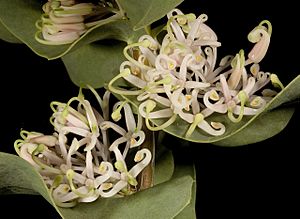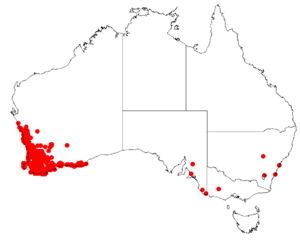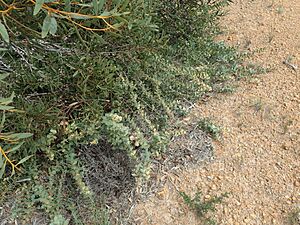Harsh hakea facts for kids
Quick facts for kids Harsh hakea |
|
|---|---|
 |
|
| Scientific classification | |
| Genus: |
Hakea
|
| Species: |
prostrata
|
 |
|
| Occurrence data from Australasian Virtual Herbarium | |
| Synonyms | |
|
Hakea glabella R.Br. |
|
Hakea prostrata, also known as harsh hakea, is a type of shrub. It is found only in the wild in the south-west part of Western Australia. This plant is a low-growing shrub. It has prickly leaves and groups of white or cream-colored flowers. These flowers appear in late winter and early spring.
Contents
What Harsh Hakea Looks Like
The harsh hakea is a shrub that usually grows to be about 1 to 3 meters (3 to 10 feet) tall. It has branches that spread out. Its leaves are shaped like an oval, wider at the top, and they wrap around the stem. The leaves also have prickly edges and a clear vein down the middle.
This plant produces many sweet-smelling flowers. They are white or cream-colored. These flowers grow in clusters where the leaves meet the stem. You can see them between July and October in its natural home.
How Harsh Hakea Got Its Name
The harsh hakea was first officially described in 1810. A botanist named Robert Brown wrote about it. He published his description in a scientific paper called Transactions of the Linnean Society of London.
The second part of its scientific name, prostrata, comes from a Latin word. This word means "down flat" or "laid low". This name refers to how this plant often grows low to the ground, especially near the coast.
Where Harsh Hakea Lives
Harsh hakea can be found along the coast of Western Australia. Its range stretches from Geraldton in the north to Esperance in the south.
It likes to grow on hillsides. You can also find it in shallow soil on top of granite rocks. It also grows on sand dunes that have become stable over time.
Conservation Status
The Western Australian Government has looked at the harsh hakea. They have classified it as "not threatened". This means it is not currently in danger of disappearing.


